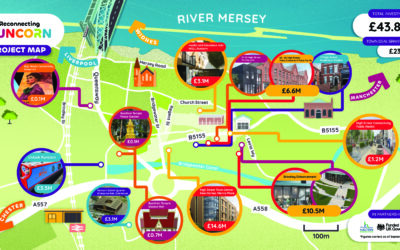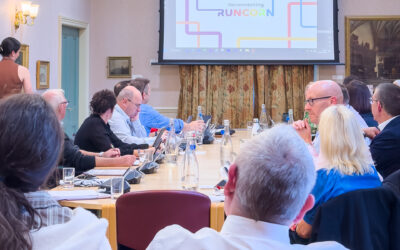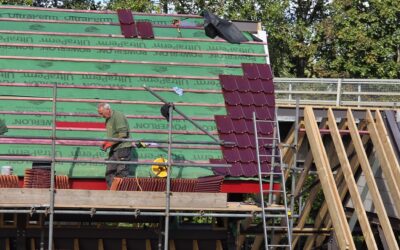Culture at the Core: Chris Bastock on Reconnecting Runcorn’s Vision for a Vibrant Future
We recently caught up with the new joint chair of the Runcorn Town Neighbourhood Board, Chris Bastock, Artistic Director of ‘A Place For Us’. Chris Bastock brings a passionate and insightful perspective to the Reconnecting Runcorn initiative. In this interview, Chris reflects on the transformative power of arts and culture, the challenges of regeneration, and the community pride driving the town’s ambitious future. From murals to major venues, he shares how creativity is helping to reshape Runcorn’s identity and inspire its next chapter.
Chris, how would you describe your role and your organisation’s role on the board so far?
I’m representing Cultivate, which is an umbrella organisation for arts groups across Halton. We’ve been active for a number of years now and have a close working relationship with the Council. We played a key role in developing the Council’s cultural strategy, Crucible of Culture, which was Halton’s first dedicated cultural strategy—so it was great to be part of that.
I think I was invited to be joint chair of the Runcorn Town Neighbourhood Board as the new Neighbourhood Plan for Towns (now renamed Plan for Neighbourhoods) came into Reconnecting Runcorn because I also chair Cultivate. That gives me a broad overview of what’s happening across the arts scene in Halton. It’s still early days in terms of impact, but what’s exciting is that arts and culture are specifically highlighted as key focus areas in the new funding. This affects not only Halton’s cultural ecology but also its economy—especially the night-time economy. Beyond that, it’s about the soft skills: well-being, inspiration, and mental health. It’s important that these aspects are represented in the group.
Culture is definitely a big part of what makes Halton and its heritage. Is that what interested you most about being part of Reconnecting Runcorn?
More than anything, it’s good to see arts and culture recognised as essential to a thriving community. If you look at places that have undergone significant change, culture is often at the heart of it. It’s something people can see and feel immediately. Take the murals going up as part of this project—they’ve generated a lot of publicity and created real feel-good moments. They help people feel better about where they live.
There’s a lot of pride in Halton, but also many challenges. So being reminded that Halton is a good place with ambition is what drew me to this programme. It’s a genuine privilege to be asked to be part of something that can make a real difference.
What have you been most proud of coming out of Reconnecting Runcorn so far?
Because I’m so involved in arts and culture, the projects that lean in that direction have been the most exciting for me. The transformation of the Brindley will have a huge impact—bringing more people in and positioning it as a cultural hub in the town centre. Linking it with the library and seeing new faces come through the doors is powerful. It opens people’s eyes to what theatre and the arts can offer.
I also have to mention the Camden Buildings. A Place for Us, where I’m Artistic Director alongside Kate Allison, will be moving into the ground floor of 63–65 High Street. That’s a game-changer for us—having a venue right in the heart of the community is huge.
What impact do you think Reconnecting Runcorn will have on the community?
It’s about possibilities and ambition. People will see more happening in the town centre—more reasons to visit the High Street, more support for new businesses, and more engagement with what’s already here. That gives businesses the chance to grow and thrive. Established venues like the Brindley will also reach new audiences who might not have previously engaged with arts and culture. Having a visible presence on the high street is a big deal—it shows people what’s possible in Runcorn.
Among all the great opportunities, what do you think have been some of the biggest challenges Reconnecting Runcorn has faced?
The vision for the programme, developed 4–5 years ago, was brilliant. But as you’d expect, the biggest challenges have been economic—especially with the cost of living crisis. It’s been tough to stay on budget while still delivering something functional and fit for purpose. That said, the regeneration team has been amazing. Collaborating with them to bring our collective vision to life, despite the challenges, has been incredibly rewarding.
You’ve been on both sides of the programme—from the project side to sitting on the board. How has that experience been? Has your project background helped in your board role?
It’s been really interesting. Before joining the board, there was a perception that things were moving slowly. You’d wonder, “How have we been talking about this project for three years and nothing’s happened?” But once you’re on the board, you understand the complexity. There are so many things you wouldn’t think about.
It’s made me appreciate the incredible work the regeneration teams are doing. Their creativity, ingenuity, and sustained enthusiasm are inspiring. Everyone involved is genuinely passionate about making a difference in Runcorn.
The passion for Runcorn and making a difference is clear when speaking to everyone involved. So, to tie this all together—what next steps are you most looking forward to for the rest of the year?
I’m looking forward to the sense of fulfilment and pride in what the board has achieved. None of these projects have been easy—there have been bumps along the way—but I hope everyone can look back and say, “We saw this through. We made a difference. We’ve set Runcorn up for the next stage—whether that’s more investment, new neighbourhood plans, or simply a better place to live.”



